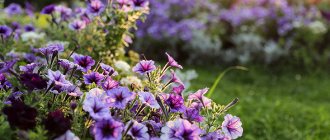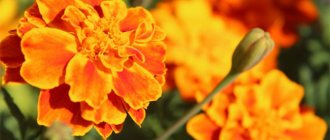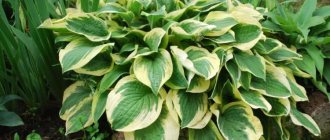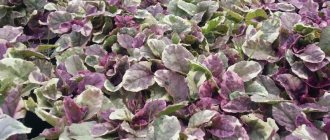Flowers of purple color with various shades represent mysterious, secret and mystical cosmic energy. It’s not for nothing that they attract so much attention and give peace, tranquility, good mood and happiness. Many gardeners like to grow purple flowers both for indoor decoration and for creating landscape design in their garden. Let's take a closer look at indoor and garden flowers.
Garden purple flowers
Garden plants with purple flowers seem simply magical against the backdrop of a green carpet of grass and leaves. We advise you to pay attention to these types!
Iris
Purple irises are a spring classic. Moreover, there are so many types that you can choose any shade to suit any climatic and geographical features of your region. There are even frost-resistant Siberian varieties.
Photo: wallbox.ru
Peony
It seems that there are peonies in the world for all occasions. There are many tall purple varieties among them, including classic double varieties.
Photo: tvplaneta.ru
Lilac
It's such an obvious option that it's easy to overlook. The lush racemose inflorescences of lilac are also good for their aroma, which envelops the entire garden and the area around it.
Photo: zen.yandex.ru
Phlox
Among phlox there are quite a lot of lilac and purple varieties. This is a long-flowering perennial with a voluminous spherical inflorescence on a long peduncle.
Photo: 7dach.ru
Aster
The most beautiful lilac varieties are found among the so-called New England ones. But breeders still do not stop in their search, so asters can be found for every taste.
Photo: pinterest.ru
Azalea
Azaleas are often grown indoors and in greenhouses, but there are also frost-resistant varieties for open ground. In the southern regions of Russia this choice is even greater!
Photo: 1zoom.ru
Gladiolus
It is difficult to find a person who has never seen gladioli. Long powerful peduncles are covered with large purple flowers, up to 20 buds per stem.
Photo: pogranec.ru
Hydrangea
Hydrangea, with its huge fluffy inflorescences that thickly cover the bush throughout the summer, needs no introduction. Some tall varieties grow up to 2 m.
Photo: avto.goodfon.ru
Delphinium
And again, lush long inflorescences on high peduncles up to 1.2-1.5 m. Delphinium grows best on loam with low acidity, and does not tolerate strong winds.
Photo: gardengallereya.ru
Wisteria
The fluffy, drooping clusters of wisteria look as if they have just stepped out of the pages of a fairy tale. This vine is amazingly shaped and suitable for decorating gazebos and facades.
Photo: goodfon.ru
Chrysanthemum
Terry purple chrysanthemums are equally good both in the garden and as a cut flower. It is one of the most vibrant and varied autumn flowers.
Photo: unipack-ug.ru
Crocus
The charming spring primrose brings joy as soon as the snow finally melts. Small, delicate crocuses look best in large groups.
Photo: demo.multiurok.ru
Astilbe
At first glance, the fluffy paniculate inflorescences of astilbe do not even look like flowers in the classical sense. This is an ethereal garden decoration that also goes well with other purple flowers.
Photo: domovodstvo.mediasole.ru
Iridodictium
Iridodictium resembles an iris, but it is very tiny - about 15 cm maximum. The bizarre shape of the purple buds immediately attracts attention. There are taller varieties - up to 30 cm.
Photo: od.vgorode.ua
Dahlia
Dahlias captivate with their huge lush flowers with a complex structure up to 18 m in diameter. The most popular purple variety among experienced gardeners is Jean Marie.
Photo: pxhere.com
Hyacinth
Hyacinths are ideal for creating borders, flower beds and multi-level compositions. On average, the height is about 30 cm, and the diameter of the flowers reaches 3-4 cm.
Photo: agrosetka74.ru
Colchicum
This charming little perennial is good for lawns or low flower beds. Colchicum blooms late and continues to delight even after the first frost.
Photo: industry60plus.ru
Tulip
It would be surprising if among the hundreds of colors of tulips there was no purple. Pay attention to the Peorple Dream and Purple Prince varieties, as well as Aria Card and Alibi.
Photo: catherineasquithgallery.com
Lupine
Lupine inflorescences are very interesting for their structure. These are dense, tall panicles of voluminous bud-boxes that gradually open from bottom to top.
Photo: avto.goodfon.ru
Lily
There are very few purple lilies, but they exist. Most often these are tubular-type varieties with unusual variegated colors, which makes them even more exotic.
Photo: u-florista.ru
Flowers that look like bells: names and photos
Unusual annuals with violet, green, lemon and purple flowers
Adding an article to a new collection
Annuals of unusual colors (violet, lemon, purple and green) are used in landscape design as bright spots of color, colorful accents that can “increase the degree” of the viewer’s attention and add drama to the composition.
Most often, the design of such a flower garden is based on complementary or, on the contrary, contrasting combinations. Just don’t forget that it’s easy to overdo it with contrasts - try to ensure that the created compositions are not too colorful, place no more than one in the field of view.
troparion and kontakion unbreakable wall
However, no one forbids you to create a monochrome flower bed or flower garden in these colors. Areas where annuals are planted in the same color scheme, but using gradations from warm to cold or from light to dark, will look especially harmonious. Such subtle differences will certainly attract everyone's gaze, forcing them to look at this magnificence again and again.
So, let's look at the bright colors in the flower garden.
Indoor purple flowers
The purple color balances perfectly on the line between red and blue. Purple flowers can miraculously create a feeling of freshness and lightness, as well as warmth and homeliness!
Himalayan geranium
It differs from other varieties of geranium in the larger diameter of its flowers. Lilac and violet with unusual red veins, they bloom up to 5 cm.
Photo: ivd.ru
Dendrobium
Dendrobium not only looks like an orchid, but also belongs to the same family. On a straight stem there are several large butterfly flowers up to 7 cm in diameter.
Photo: vse.kz
Primrose
A charming flower bush will delight you at the beginning of spring. The leaves are collected in a compact rosette, above which rises a voluminous umbrella inflorescence.
Photo: tr.pinterest.com
Achimenes Ehrenberg
The compact flower grows no more than 50 cm and delights with large purple buds for several months a year. The outer side of the petals is pink, and in the center there is a reddish center.
Photo: id.tricornmedals.com
Shaggy slipway
The first succulent on our list of purple indoor flowers! The bush is very compact, takes up almost no space and is densely covered with fleecy star-shaped flowers of a rich eggplant shade.
Photo: yesofcorsa.com
Violet
She is also Saintpaulia. Of the hundreds of varieties of violets, there are at least several dozen purple ones. Moreover, the buds can be anything: not only simple and terry, but also the most bizarre shapes.
Photo: allo-cveti.ru
Passionflower
Passionflower belongs to the vines, and at first glance it is not very noticeable. But everything changes when it blooms with spectacular purple flowers of a very complex exotic structure.
Photo: livelib.ru
Gloxinia
The tuberous perennial blooms with large purple bells against a background of velvety green leaves. Gloxinia flowering under favorable conditions lasts up to 2 months.
Photo: pinterest.ca
Fuchsia
The selection would be incomplete without the charming fuchsia. Among the variety of pink and raspberry varieties, there are also spectacular purple ones. Fuchsia is good because it blooms very wildly and for a long time.
Photo: cvetyphoto.blogspot.com
Purple calla
Purple calla is a rather rare and exotic variety of this flower. But its luxurious appearance makes up for all the difficulties in finding and caring for it.
Photo: greenhousevillage.ru
Ruellia
A charming tropical flower, very delicate and airy. The petals may be blue or blue. Ruellia blooms for a long time and does not cause any trouble if you choose a sunny corner for it.
Photo: prorastet.ru
Streptocarpus
Externally, the flower with a fancy name is very reminiscent of a violet with its jagged leaves and a flower crown on top. But streptocarpus flowers are funnel-shaped, with very complex colors.
Photo: ginger-slim.ru
Cyclamen
Cyclamen's powerful rhizome makes it resistant to adverse conditions and ideal for beginners. Drooping purple flowers on long thin stalks look like fantasy boxes.
Photo: pixabay.com
Hemigraphis
And for variety, let’s add an unusual indoor plant with purple leaves to the selection. Basically you want exotic, colored, interleaved or wide-notched hemigraphis.
Photo: tsveto.ru
Herbaceous
Small purple flowers appear more often on annual or perennial bulbous plants. They stand out impressively when surrounded by white, red or yellow buds of other representatives of flower crops. If you combine them correctly within the framework of landscape design, you will get an effective composition.
Aster
Modest autumn flowers come in different colors: there are varieties with lilac, lilac or violet inflorescences (Fremont, European). Early species delight with bright buds in the summer, late ones can bloom until October-November.
The stem of the aster reaches a length of 40 cm. The leaves are carved and pointed. The culture looks great in flower beds, along borders, surrounded by other herbaceous plants.
Hyacinth
A bulbous crop that belongs to the Asparagus family. Blooms in mid-spring. The inflorescences look like pyramids, collected from small buds of bright purple or lilac shades.
Plants emit a pleasant smell. They are stable, unpretentious, easily take root in any soil, but require watering. No wonder the name of the culture is translated as “rain flower”.
Delphinium
This is a whole genus of plants, including varieties with a rich color palette of buds: from purple to lilac or violet tones. The most spectacular are Kleine Nachtmusik, Black Knight, King Arthur. The inflorescences are lush, semi-double, with rich color.
The plant loves fertile soils and responds well to watering and fertilizing. However, excessive humidity causes fungal diseases, so when caring for delphiniums, moderation and increased attention to the condition of the flower are required.
A delicate dark purple flower that looks like an open mouth. The buds bloom in early summer, delighting with bright colors. Irises are unpretentious and take root well in any soil. There are Siberian frost-resistant varieties that can withstand extreme cold without problems: Tropic Knight, Tiffany Wood.
In good conditions, the crop can reach a height of up to 1 m. Irises are suitable for planting in any part of the flower garden, in flower beds, near building walls or fences. They look especially beautiful against the backdrop of trimmed lawn grass.
Clematis
The plant is herbaceous or in the form of a vine with weaving shoots reaching a length of 10 m. This beauty is planted along fences, near gazebos. As it grows, it entwines the trellis, turning it into a blooming canvas.
White-purple inflorescences are found in varieties President, Polish Spirit, Ville de Lyon, Vivian Pennel. The plant does not require much attention because it is unpretentious and tolerates cold well.
Crocus
A bulbous crop belonging to the Iris family. In spring, spherical inflorescences with a diameter of 4-5 cm appear. The buds seem to glow from within due to the uneven distribution of tone. They open only in sunny weather.
The Queen of the Blues crocus variety has the most delicate color. Among the popular ones are Ruby Dzhaent, Remembrance, Flower Record. The plants are unpretentious and thrive in both shaded and sunny areas. Frost-resistant, take root on any soil where there is no stagnant moisture. They grow in one place for up to 5 years.
Source
Oak sage
This perennial plant is characterized by large lower leaves and small upper leaves. Long inflorescences grow up to 40 cm in height, while the shrub itself does not exceed 60 cm. The violet-blue flowers of sage are not too large, but due to the fact that they are collected in whorls of 2-6 pieces, such “tassels” look very elegant.
Among the plants of the genus Sage, this species is considered one of the most unpretentious. Yet it grows best in open, sunny areas with light, permeable soil. If you plant sage in heavy clay soil, it will begin to rot.
The plant has a pleasant smell that can be felt even from a distance
Fassin's catnip
Catnip will fit perfectly into a garden of purple shades. A plant with small lilac-lilac flowers, collected in spike-shaped panicles, reaches a height of 60 cm. The perennial will delight you with abundant and long-lasting flowering, as well as a strong lemon aroma.
The only place where a perennial will grow poorly is in an area with heavy soils. In general, the plant is quite unpretentious in care. However, it is worth remembering that large flowers can be obtained from it only when grown in an open, sunny area with light, fertile soil.
During flowering, catnip can repel pests and purify the air.
creeping thyme
This plant is one of the smallest among ornamental herbs. Its height is only 15 cm, but nevertheless this small shrub deserves the attention of gardeners. Pink-purple thyme flowers, collected in fluffy inflorescences, look great against the backdrop of leathery lance-shaped leaves. The plant grows very quickly, forming “soft cushions”, and exudes a pleasant aroma.
Thyme will do best in open, sunny areas. Of course, you can grow it in partial shade, but in such conditions it will bloom much worse. Choose soils with a neutral or slightly alkaline reaction for the plant, and it will delight you with flowering for a long time.
Thyme pillows look good on alpine slides and gardens
Lofant anise
Another plant with flowers in blue and lilac tones is lofant. Only, in comparison with previous modest crops, this perennial can reach a height of 1.5 m. Small flowers form large spike-shaped inflorescences.
For a flower to really become a decoration of your garden, it should be planted in open sunny areas with fertile, loose soil. Lofant tolerates drought quite well, but still requires more moisture than usual during flowering. And although this perennial is considered cold-resistant, for the winter it is better to cover it with spruce branches or sprinkle it with a layer of peat.
Anise lofant is an excellent honey plant, so bees and bumblebees always hover around it
Lavender angustifolia
This shrub, beloved by many, migrated to our gardens from the mountain slopes of the Mediterranean. Lush round bushes of a rich purple hue grow up to 60 cm in height. The decoration of the plant can be considered not only the spike-shaped inflorescences with lilac and blue flowers collected in whorls, but also narrow silvery leaves.
Lavender is not too demanding when it comes to growing conditions. The main thing is to choose a dry and sunny area for it, and do not forget to prune it in the spring. Then the plant will delight you with its bright colors and wonderful aroma for a long time.
Although not all gardeners can get along with lavender, you can still find an approach to it
Monarda tubular
One of the highest representatives of our selection of wonderful spices is monarda. It grows up to 120 cm in height and is distinguished by bright spherical capitate inflorescences. In fact, the flowers of the plant are small, but they are collected in false whorls, which in turn form inflorescences that from a distance resemble whole flowers.
Like most herbs, flowering monarda makes a wonderful addition to your flowerbed or border when grown in open, sunlit areas. But keep in mind that this plant really does not like drafts. Monarda also does not tolerate heavy soil in which moisture stagnates.
Monarda tubularis is a very beautiful plant that is suitable not only for a purple garden
As you can see, caring for most herbs is almost the same. Therefore, it will not be difficult for you to grow several varieties of them at once. Try planting these delightful flowers and your garden will sparkle with luxurious purple hues.
Source
Oregano
This beautiful perennial plant is a must-have for gardeners who want to attract butterflies to the garden. The branched, pubescent, reddish stems of oregano usually grow up to 80 cm in height. Small purple-pink flowers are collected in inflorescences that resemble small brushes. They bloom in July and continue to delight with rich colors until September.
The plant is absolutely unpretentious, so growing it will not be difficult. But in order for oregano to show itself in all its glory, some of its “wishes” should still be taken into account. So, this plant will feel best in sunny or slightly shaded areas of the garden. The soil can be any kind, but drainage is required, because the only thing that oregano cannot tolerate is stagnation of water in the soil.
Essential oils released by oregano during flowering repel garden pests











